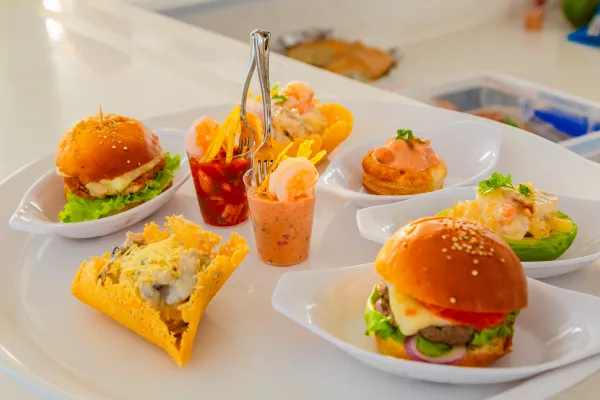
What Was Eaten on the First Catamarans?
The history of catamarans is also written with salt, fire, and tropical fruits
Before catamarans became symbols of luxury, private excursions, and seaside celebrations —as Flamante Catamarán is today in Cartagena— these vessels were key to exploring, populating, and trading across the oceans. But what did the first sailors who embarked on these journeys eat?
This blog is an invitation to explore not only ancestral naval architecture, but also the diet and food rituals that accompanied catamaran voyages in their origins. Because at sea, food was more than sustenance: it was identity, culture, and survival.
A Polynesian Origin: Cooking on Water
The first catamarans were born in Polynesia, and their dual construction allowed stability for long distances. The inter-island voyages, which could last weeks, required clever food logistics. There were no refrigerators or modern stoves, but there was extraordinary skill in preserving and cooking under marine conditions.
Among the most common foods on board were:
Cooked or fermented taro: this tuber was essential and was cooked in underground stone ovens (imu) before setting sail.
Dried or smoked fish: the sea provided protein, and Polynesians knew how to preserve it.
Fruits like coconut, guava, or breadfruit, which resisted heat and salinity.
Edible seaweed, which provided minerals and was easy to collect.
Cooking was sometimes done on portable braziers, carefully protected from the wind. But most food was prepared on land and stored in palm leaves, woven baskets, or dried gourds.
Eating at Sea Was Also a Ceremony
In many Pacific cultures, eating aboard the catamaran wasn’t just a necessary pause, but a spiritual act. Before starting a voyage, food was offered to the gods of the sea, and strict communal rules were followed during the trip: who could eat first, how the fish was shared, which fruits were sacred.
These practices were part of a worldview in which the sea was a living deity. Eating on its surface demanded respect, moderation, and gratitude. A philosophical echo that, centuries later, can be felt in conscious maritime experiences like that of Flamante Catamarán, where connection with nature is an integral part of each voyage.
Colonial Influences: New Ingredients Onboard
With the arrival of Europeans in the Caribbean and contact with the native peoples of the Americas, catamarans and other vessels began to include products from the transatlantic exchange. From the 15th century onward, ingredients like wheat flour, salted cod, chickpeas, and wine became part of the dietary repertoire of sailors from different regions.
In colonial Caribbean ships, and occasionally in catamarans adapted for coastal transport, it was common to find:
Hardtack: hard, dry bread that could last for months.
Salted pork and preserved meat: sources of fat and protein.
Rum, chicha, or wine: not only for pleasure but to prevent diseases related to contaminated water.
Tropical fruits collected on islands along the route, such as pineapple, plantain, or papaya.
Although food remained austere, it became more diverse. And where ingredients mixed, new ways of cooking at sea were born.
But it wasn’t all survival and meager rations. As routes were solidified and catamarans took on a broader role in the lives of island communities, more elaborate cooking methods onboard also developed. Some vessels carried volcanic stones or iron plates to improvise stoves, and sailors learned to dehydrate fruits, salt fish, and ferment drinks to extend their shelf life. These practices, born of necessity, were also the seeds of a maritime cuisine that we admire today in many coastal cultures. Thus, the first catamarans were not only vehicles of discovery, but also of culinary exchange.
Flavors Floating Between Centuries
Today, boarding a catamaran like Flamante doesn’t involve rationing dried fish or worrying about the shelf life of a coconut. But there is a fascinating continuity between the feasts of the past and today’s culinary experiences at sea.
When a fresh ceviche is served before the Cartagena horizon or a cheese board with tropical fruits, we are —without knowing it— paying homage to all those sailors who crossed the sea with ingenuity, hunger, and devotion to life.
Flamante: An Experience You Can Also Taste
At Flamante Catamarán, we understand that every detail onboard tells a story. That’s why our experiences include fresh, local gastronomic options adapted to contemporary tastes, but with a respectful nod to maritime tradition.
Whether celebrating a special occasion, enjoying a private cruise, or sailing for the first time in the Colombian Caribbean, each journey with Flamante is a connection with the sea and its history… also through the palate.
